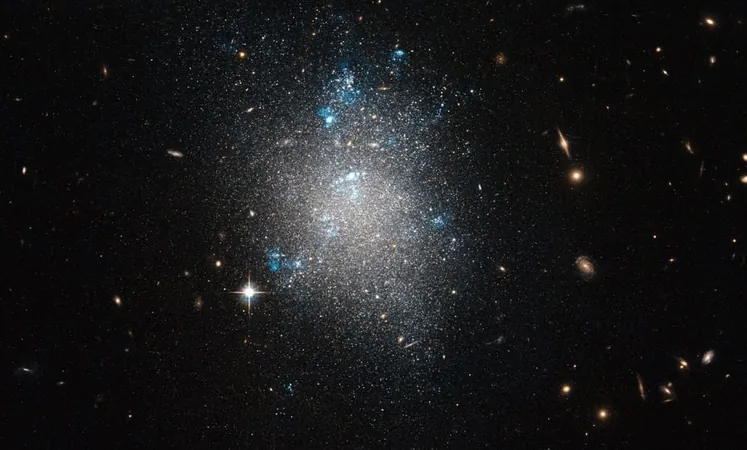
Unlocking the Secrets of Dwarf Galaxies: Are They Hiding Tiny Satellites?
2025-08-06
Author: Sarah
A Cosmic Puzzle: The Evolution of Dwarf Galaxies
In the vast universe, the evolution of galaxies is a critical focus, and new insights reveal that even smaller dwarf galaxies, like the Large and Small Magellanic Clouds, could possess their own minuscule satellite galaxies. Researchers at Dartmouth College are exploring this tantalizing possibility as they seek to expand our understanding of these lesser-known cosmic structures.
ID-MAGE: A Bold New Survey
Their groundbreaking research, titled "Identifying Dwarfs of MC Analog GalaxiEs (ID-MAGE)," is now documented in The Astrophysical Journal. Lead author, Laura Hunter, emphasizes the need to investigate low-mass galaxies and their potential satellite companions, challenging the Lambda Cold Dark Matter (CDM) model that predicts galaxy growth through mergers.
Hunting for Satellite Galaxies Across the Cosmos
The ID-MAGE survey targeted 35 dwarf galaxies comparable in mass to the Magellanic Clouds, lying between 4 and 10 megaparsecs away (approximately 13 to 32.6 million light-years). By meticulously analyzing vast datasets from the Dark Energy Spectroscopic Instrument (DESI) Legacy Imaging Surveys, the team identified an impressive 355 candidate satellite galaxies, with 264 being new discoveries!
These 35 galaxies were selected for their varied sizes and proximity to other galactic structures, allowing researchers to discern how these factors might influence satellite formation. The quest for knowledge focuses on whether smaller galaxies can indeed attract and hold onto even smaller celestial bodies, validating theoretical models.
Visualizing the Cosmic Neighborhood
Interesting findings reveal that larger galaxies tend to host more dwarf galaxies, which seems intuitive at first glance. But does this relationship apply to less massive galaxies as well? Hunter asserts that the survey aims to uncover the truth about smaller host galaxies and their ability to attract dwarf companions.
A Two-Step Approach to Discovery
Determining which of the satellite candidates were genuine involved a rigorous two-step process. Initially, advanced algorithms filtered out background noise from images, such as light from other stars. Following this, team members conducted a detailed visual inspection to eliminate any potential image defects.
Positive Alignment with Cosmological Models
Remarkably, their observations aligned with existing cosmological models. On average, 4.0 high-likelihood satellite candidates were found per LMC-mass host and 2.1 for SMC-mass hosts, solidifying predictions made by CDM theory.
The Path Ahead: Confirming Satellite Candidates
This initial discovery phase sets the stage for the researchers' future efforts, which involve confirming these candidates as legitimate satellite galaxies. Follow-up investigations will determine their mass, distribution, and star formation rates, all crucial pieces to the cosmic puzzle.
In their concluding thoughts, the authors highlight the importance of their findings for understanding satellite galaxy populations influenced by host galaxy mass. Future observations promise to deepen our knowledge of the complex processes driving galaxy formation and evolution.
Unlocking Dark Matter Mysteries
As study co-author Burçin Mutlu-Pakdil notes, uncovering the mysteries surrounding these dwarf satellites requires significant resources and telescope time—but the potential revelations about dark matter and the mechanics of galaxy formation could be revolutionary. Each discovery could hold vital clues about our universe's origin and structure.



 Brasil (PT)
Brasil (PT)
 Canada (EN)
Canada (EN)
 Chile (ES)
Chile (ES)
 Česko (CS)
Česko (CS)
 대한민국 (KO)
대한민국 (KO)
 España (ES)
España (ES)
 France (FR)
France (FR)
 Hong Kong (EN)
Hong Kong (EN)
 Italia (IT)
Italia (IT)
 日本 (JA)
日本 (JA)
 Magyarország (HU)
Magyarország (HU)
 Norge (NO)
Norge (NO)
 Polska (PL)
Polska (PL)
 Schweiz (DE)
Schweiz (DE)
 Singapore (EN)
Singapore (EN)
 Sverige (SV)
Sverige (SV)
 Suomi (FI)
Suomi (FI)
 Türkiye (TR)
Türkiye (TR)
 الإمارات العربية المتحدة (AR)
الإمارات العربية المتحدة (AR)